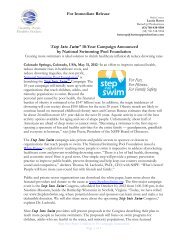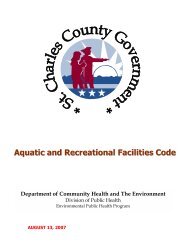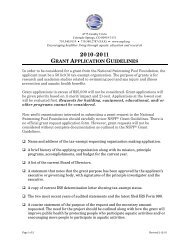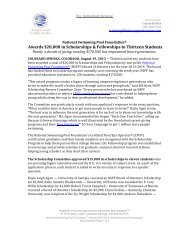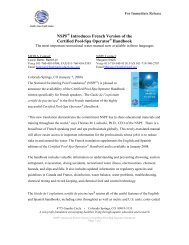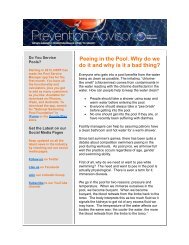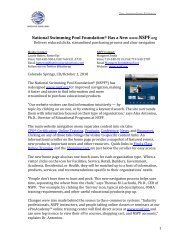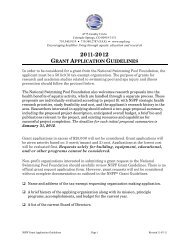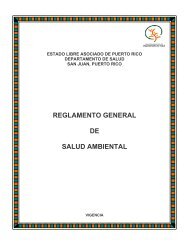English Instructor Manual (PDF) - Metric Version - National ...
English Instructor Manual (PDF) - Metric Version - National ...
English Instructor Manual (PDF) - Metric Version - National ...
You also want an ePaper? Increase the reach of your titles
YUMPU automatically turns print PDFs into web optimized ePapers that Google loves.
Key Points: Discuss water chemistry concerns for a spa or therapy pool. Emphasize that to<br />
maintain proper water chemistry, circulation systems must operate 24 hours continuously. These<br />
include:<br />
Maintaining proper water balance. Hot water tends to play havoc with chemical levels.<br />
As these levels fl uctuate, water frequently becomes unbalanced, making the water<br />
conditions not only bad for the pool, but also bad for bathers.<br />
Maintaining proper disinfectant levels. Because of the increased potential for<br />
hazardous biological contamination, many regulations and standards allow for higher<br />
disinfectant levels than in a pool. Chlorine levels as high as 10.0 mg/L are commonly<br />
allowed.<br />
Monitoring TDS levels. In the previous example where 6 people in a spa equaled 275<br />
people in a pool, one can imagine how that affects the amount of chemicals that have<br />
to be added to maintain proper water chemistry. Added to that, the bathers themselves<br />
tend to excrete more bodily fl uids. All of this just adds to the TDS levels, requiring more<br />
frequent draining and refi lling of the therapy pools and spas.<br />
Key Points: Discuss the areas where codes and standards apply to spas and therapy pools.<br />
These include:<br />
Bather load restrictions. Many regulatory agencies set limits for how many people that<br />
can be in a hot water vessel at a given time. This has traditionally been one bather for<br />
every 3 square metres of surface area.<br />
Water chemistry. As was mentioned previously, hot water creates numerous water<br />
chemistry concerns. Often regulations require higher levels of disinfectant and more<br />
frequent monitoring of those levels. Because of the frequent fl uctuation of other<br />
chemical levels, it is often more diffi cult to maintain consistent water balance.<br />
Circulation requirements. Because of the operational concerns mentioned earlier,<br />
many regulatory agencies and standards call for much faster turnover rates than pools.<br />
For example, therapy pools generally have a 3-4 hour turnover rate while spas have a<br />
30-minute turnover rate. In addition, regulations require fl ow to not exceed the specifi ed<br />
limits for drain covers to prevent entrapment.<br />
Temperature. While temperatures for therapy pools are generally based more on<br />
comfort than regulation, spas have a 40°C temperature maximum.<br />
Health and safety. In many cases, other standards and regulations are in place to<br />
safeguard health and safety. Some include circulation system requirements such as<br />
anti-vortex drains, timers that shut off hydrotherapy pumps (making it necessary to leave<br />
the spa to turn the system back on) and special signage that restricts usage.<br />
Key Points: Discuss the types of people who might be at risk using hot water pools and spas.<br />
These include:<br />
Pregnant women<br />
Elderly<br />
Children<br />
Individuals with heart disease<br />
Individuals with high blood pressure<br />
Individuals under the infl uence of drugs or alcohol<br />
Users of prescription medication<br />
© 2014 <strong>National</strong> Swimming Pool Foundation® Page 83



